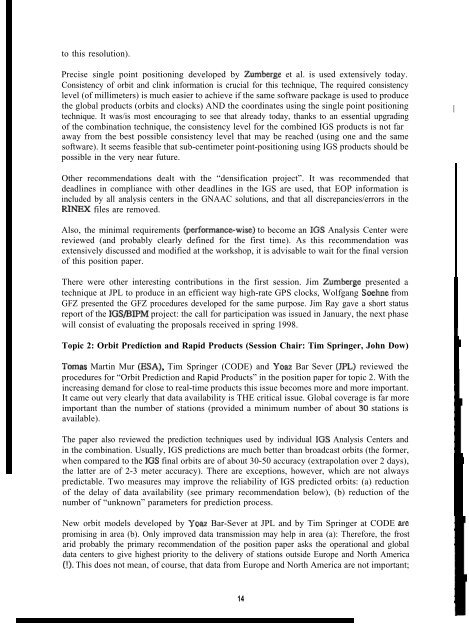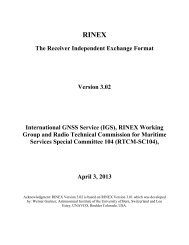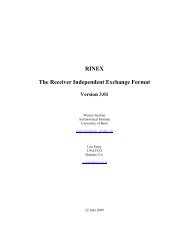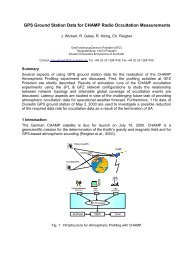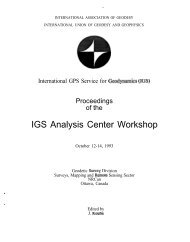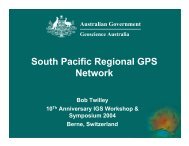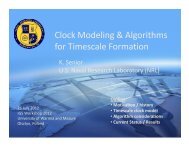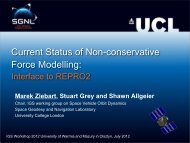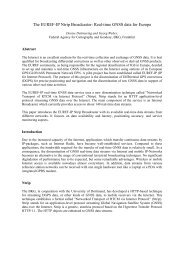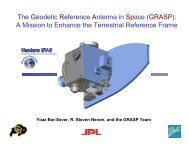- Page 1 and 2: T 8 A N A L Y S I S CENTER WORKSHOP
- Page 3 and 4: FOREWORD The 1998 Analysis Centre W
- Page 5 and 6: TABLE OF CONTENTS Foreword . . . .
- Page 7 and 8: S. Schaer, W. Gurtner, J Feltens Th
- Page 9 and 10: Programme of Workshop 1
- Page 11 and 12: @esa m=l, ::=mlllll lx= mj:n IGS AN
- Page 13 and 14: ,.,,. ,:, -.. ., ,,.Y @esa 9=II::=R
- Page 15 and 16: EXECUTIVE SUMMARYl G. Beutler The 1
- Page 17 and 18: activities one has the problem that
- Page 19: future tasks are clearly defined. M
- Page 23 and 24: Ionosphere The position paper “IG
- Page 25 and 26: SUMMARY RECOMMENDATIONS OF THE DARM
- Page 27 and 28: 6. That a (super) combination of G-
- Page 29 and 30: Annex IGS Fiducials for ITRF Refere
- Page 31 and 32: ● coordinates and velocities of t
- Page 33 and 34: archiving, site and RINEX standards
- Page 35 and 36: it is unlikely that a single person
- Page 37 and 38: GOVERNING BOARD The Governing Board
- Page 39 and 40: Topic 1: The IGS Analysis Products
- Page 41 and 42: used, the consistency between all t
- Page 43 and 44: Consistency between the IGS orbits
- Page 45 and 46: Table 1. Median daily repeatabiliti
- Page 47 and 48: Of course the inclusion of bad sate
- Page 49 and 50: consistent with the IGS reference f
- Page 51 and 52: GNAAC, of providing station coordin
- Page 53 and 54: One large future “customer” of
- Page 55 and 56: seconds. A format for station and s
- Page 57 and 58: Zumberge, J. F., M. B. Heflin, D. C
- Page 59 and 60: INTRODUCTION PRECISE HIGH-RATE SATE
- Page 61 and 62: FIXED STATION CLOCKS APPROACH A sec
- Page 63 and 64: 250 -150- - -250- 3.00 3.33 3.66 4.
- Page 65 and 66: HIGH-RATE STATION CLOCKS One advant
- Page 67 and 68: INTRODUCTION THE IGS/BIPM TIME TRAN
- Page 69 and 70: A type of point positioning likely
- Page 71 and 72:
differences. This is probably suffi
- Page 73 and 74:
Topic 2: Orbit Prediction and Rapid
- Page 75 and 76:
The factors that limit the accuracy
- Page 77 and 78:
Table 1. Number of stations availab
- Page 79 and 80:
Table 3. Effect of different pertur
- Page 81 and 82:
Table 4. Orbit fit (7-day) and orbi
- Page 83 and 84:
A more than twofold improvement in
- Page 85 and 86:
60 40 Ii . . . ..- ● E WC.W 2 heu
- Page 87 and 88:
10 5 t t + IV (cm) ☞ ☞ IGS rapi
- Page 89 and 90:
Broc~dcast orbits for non—eclipsi
- Page 91 and 92:
Table 1. Effect of different Pertur
- Page 93 and 94:
where aD~, aDC, aDS, aye, aye, ays,
- Page 95 and 96:
: : m . > > : ~ ~ g z 2 CPS WEK (a)
- Page 97 and 98:
Table 2. Selected “optimal” orb
- Page 99 and 100:
lines in both plots showing the Do
- Page 101 and 102:
The RPR model is based on the time
- Page 103 and 104:
likely caused by the eclipsing sate
- Page 105 and 106:
Appendix This Appendix gives some s
- Page 107 and 108:
NEW SOLAR RADIATION PRESSURE MODELS
- Page 109 and 110:
120 100 20 \ lm 10m J-IA c Ic predi
- Page 111 and 112:
Using the current GNSS systems, use
- Page 113 and 114:
meter, this will be sufficient to p
- Page 115 and 116:
Standards and meteorological loggin
- Page 117 and 118:
decades, This package has been exte
- Page 119 and 120:
mainly due to the bad geometrical c
- Page 121 and 122:
corrections can be compensated by c
- Page 123 and 124:
These results can be compared with
- Page 125 and 126:
BACKGROUND POTENTIAL USE OF ORBIT P
- Page 127 and 128:
were used to validate the basic des
- Page 129 and 130:
METOP a.m. GRAS data as parl 0( the
- Page 131 and 132:
parameters of both the ‘model wor
- Page 133 and 134:
A critical aspect is given by the d
- Page 135 and 136:
Topic 3: IGS Reference Frame Realis
- Page 137 and 138:
“A global IGS reference system”
- Page 139 and 140:
determinations (largely free of the
- Page 141 and 142:
Fig. 2. of IGS he Proposed set of 5
- Page 143 and 144:
software. As seen from Table 2 and
- Page 145 and 146:
of about 0.2 mas are expected, it i
- Page 147 and 148:
. All the A-SINEX files (with stati
- Page 149 and 150:
choose (unconstrained, minimum) to
- Page 151 and 152:
and semiannual effects for some sta
- Page 153 and 154:
Zumberge, J. F, M.B. Heflin, D.C. J
- Page 155 and 156:
Africa/Arabia : BAHR r,e,n,s Z12 0.
- Page 157 and 158:
However there will be something lik
- Page 159 and 160:
TROM TSKB VILL WES2 WTZR YAR1 YELL
- Page 161 and 162:
Sigma CAS1 DAV1 MCM4 OHIG KERG Mean
- Page 163 and 164:
Example #1: Minimum datum (rotation
- Page 165 and 166:
APPENDIX VI SUGGESTIONS AND DISCUSS
- Page 167 and 168:
Table 1: 7 parameter orbit and stat
- Page 169 and 170:
ITRF96 AND FOLLOW ON FOR 1998 Claud
- Page 171 and 172:
Table 1. Global ITRF96 residuals pe
- Page 173 and 174:
INTRODUCTION IGS REFERENCE STATIONS
- Page 175 and 176:
Class D: Velocity residuals larger
- Page 177 and 178:
(MCM466001MO03). These stations sho
- Page 179 and 180:
ABSTRACT ESTIMATION OF NUTATION TER
- Page 181 and 182:
that the VLEII formal errors will o
- Page 183 and 184:
with oj denoting a combination of t
- Page 185 and 186:
Figure 5. 0.20 0.15 0.10 0.05 0.00
- Page 187 and 188:
GLOBALLY CONSISTENT RIGID PLATE MOT
- Page 189 and 190:
I The velocity of a point that is f
- Page 191 and 192:
mass (which we assume to be Euler
- Page 193 and 194:
otated into ITRF using a 14-paramet
- Page 195 and 196:
can arise because the station actua
- Page 197 and 198:
. In northern Algeria, convergence
- Page 199 and 200:
Topic 4: IGS Products for Troposphe
- Page 201 and 202:
that all coordinates refer to the s
- Page 203 and 204:
GFZ are extracted for 90 days at th
- Page 205 and 206:
15. ~2. CODE 9. 6. 3, 00 15. 12, 9.
- Page 207 and 208:
10 4 8. 2. I 890. 893. 8%. 899. 902
- Page 209 and 210:
18. 12. n 6. 2 ~ ‘“ N -6. -12.
- Page 211 and 212:
L 10. I 5. r o. L-- 97250. 40. 35.
- Page 213 and 214:
1. Verification of DWD Weather Fore
- Page 215 and 216:
5. DAILY BKG SOLUTION, GREF PART, D
- Page 217 and 218:
ESTIMATING HORIZONTAL GRADIENTS OF
- Page 219 and 220:
ABSTRACT IGS PRODUCTS FOR THE IONOS
- Page 221 and 222:
POTENTIAL PARTICIPANTS IN A ROUTINE
- Page 223 and 224:
TOWARDS A COMBINED IGS IONOSPHERE P
- Page 225 and 226:
GOALS AND NEXT STEPS For the near f
- Page 227 and 228:
IONEX: The ionosphere Map EXchange
- Page 229 and 230:
From method (1) to method (3), one
- Page 231 and 232:
Reading and Writing IONEX Modules F
- Page 233 and 234:
I I I I I I I I I contained in curr
- Page 235 and 236:
Table 2: Ionosphere map file — da
- Page 237 and 238:
1000 1000 1000 1000 1000 1000 1000
- Page 239 and 240:
1000 1000 1000 1000 1000 1000 1000
- Page 241 and 242:
Table 2: Differential code biases
- Page 243 and 244:
This equation can be rewritten in f
- Page 245 and 246:
In practice, the combined biases (r
- Page 247 and 248:
w o z w & LLl IL LL E DENT -BRUS (D
- Page 249 and 250:
10.00 ‘ - — 5.00 ‘- -- 0.00
- Page 251 and 252:
In a similar way as Wanninger (1994
- Page 253 and 254:
anging fi-om a few minutes to sever
- Page 255 and 256:
CONCLUSIONS The paper has outlined
- Page 257 and 258:
ABSTRACT MONITORING THE IONOSPHERE
- Page 259 and 260:
check and/or improve well-known ion
- Page 261 and 262:
1990). Collecting more and more TEC
- Page 263 and 264:
References Davies K., W. Degenhardt
- Page 265 and 266:
The main part of the paper will the
- Page 267 and 268:
One indicator of accuracy is the da
- Page 269 and 270:
Figure 3: Global TEC map from GE fi
- Page 271 and 272:
90 45 0 -45 -90 -100 -90 0 90 10< F
- Page 273 and 274:
When comparing the TEC maps in Figu
- Page 275 and 276:
Chapman Profile approach, thus prov
- Page 277 and 278:
points, but represent the integral
- Page 279 and 280:
Cosz cosine of slant range zenith d
- Page 281 and 282:
if not linear - the unknown paramet
- Page 283 and 284:
geometrical conditions can arise, a
- Page 285 and 286:
Establishment of Linearized Observa
- Page 287 and 288:
spending tracking data, the SST opt
- Page 289 and 290:
THE ROLE OF GPS DATA IN IONOSPHERIC
- Page 291 and 292:
(e.g., using the 40 and 360 MHz sig
- Page 293 and 294:
Retrospective nowcasting Retrospect
- Page 295 and 296:
(chairman: R. Leitinger, Austria, c
- Page 297 and 298:
● ● ● ● 24-hour global iono
- Page 299 and 300:
G .- 0 y 180 -150 -120 -90 -60 -30
- Page 301 and 302:
E 9 .2 ?: j ~ ?4 ?30 ~“ ~z % :’
- Page 303 and 304:
c c E c .- E! !2 %0 . m t 1 1 0 200
- Page 305 and 306:
,$ ., L r 1 (a) TEc maps Figure8. 2
- Page 307 and 308:
Rothacher, M., G. Beutler, E. Brock
- Page 309 and 310:
Experiences of the BKG in Processin
- Page 311 and 312:
RINEX N-l?ite for GPS modified Kepl
- Page 313 and 314:
The combined SP3-fde includes also
- Page 315 and 316:
1) Set up n single difference ambig
- Page 317 and 318:
0.10 a) z g 0.06 0.02 Figure 5: Fra
- Page 319 and 320:
[ 1) Compute triple difference resi
- Page 321 and 322:
PRECISE AUTONOMOUS EPHEMERIS DETERM
- Page 323 and 324:
ephemeris message will be computed
- Page 325 and 326:
The solution to the problem can be
- Page 327 and 328:
integration period, e.g. 5 minutes
- Page 329 and 330:
LATITUDE (DEG) 9L . . 6& - ;+5 ,- o
- Page 331 and 332:
First from the generation of the si
- Page 333 and 334:
it is believed that, with dedicated
- Page 335 and 336:
needed in order to use them as yard
- Page 337 and 338:
close to the maximum. It was decide
- Page 339 and 340:
Summary IGS Related Activities at t
- Page 341 and 342:
Table 1. Point positioning using NR
- Page 343 and 344:
ESA/ESOC IGS ANALYSIS CENTRE POSTER
- Page 345 and 346:
ESTIMATION OF MANOEUVRES Manoeuvres
- Page 347 and 348:
TROPOSPHERIC ESTIMATES Tropospheric
- Page 349 and 350:
Sever (JPL) and Gerd Gendt (GFZ). S
- Page 351 and 352:
A REVIEW OF GPS RELATED ACTIVITIES
- Page 353 and 354:
2.5 2.0 1.5 ~ 1.0 % E 0.5 x 0.0 -0.
- Page 355 and 356:
TEC from the CORS Network Figure 4
- Page 357 and 358:
REFERENCES Cartwright, D.E., and R.
- Page 359 and 360:
In recent years, the Bulletin A pol
- Page 361 and 362:
frequency reference. A second recei
- Page 363 and 364:
THE IGS REGIONAL NETWORK ASSOCIATE
- Page 365 and 366:
IJJcl UKJ 4“’’’’’’’
- Page 367 and 368:
W.-,-,- ,,, IJJ3 d , , , ,. . . . !
- Page 369 and 370:
Variations of weekly SIR R solution
- Page 371 and 372:
Variations of weekly SIR R solution
- Page 373 and 374:
Variations of weekly SIR R solution
- Page 375 and 376:
w’ —— L .sT41w.!l. c8Q#_. .J
- Page 377 and 378:
T HE N EWCASTLE G LOBAL N ETWORK A
- Page 379 and 380:
6 5 4 23 2 1 0 S TRATEGY Figure 2:
- Page 381:
IGS Workshop Dinner, Jagschloss Kra


